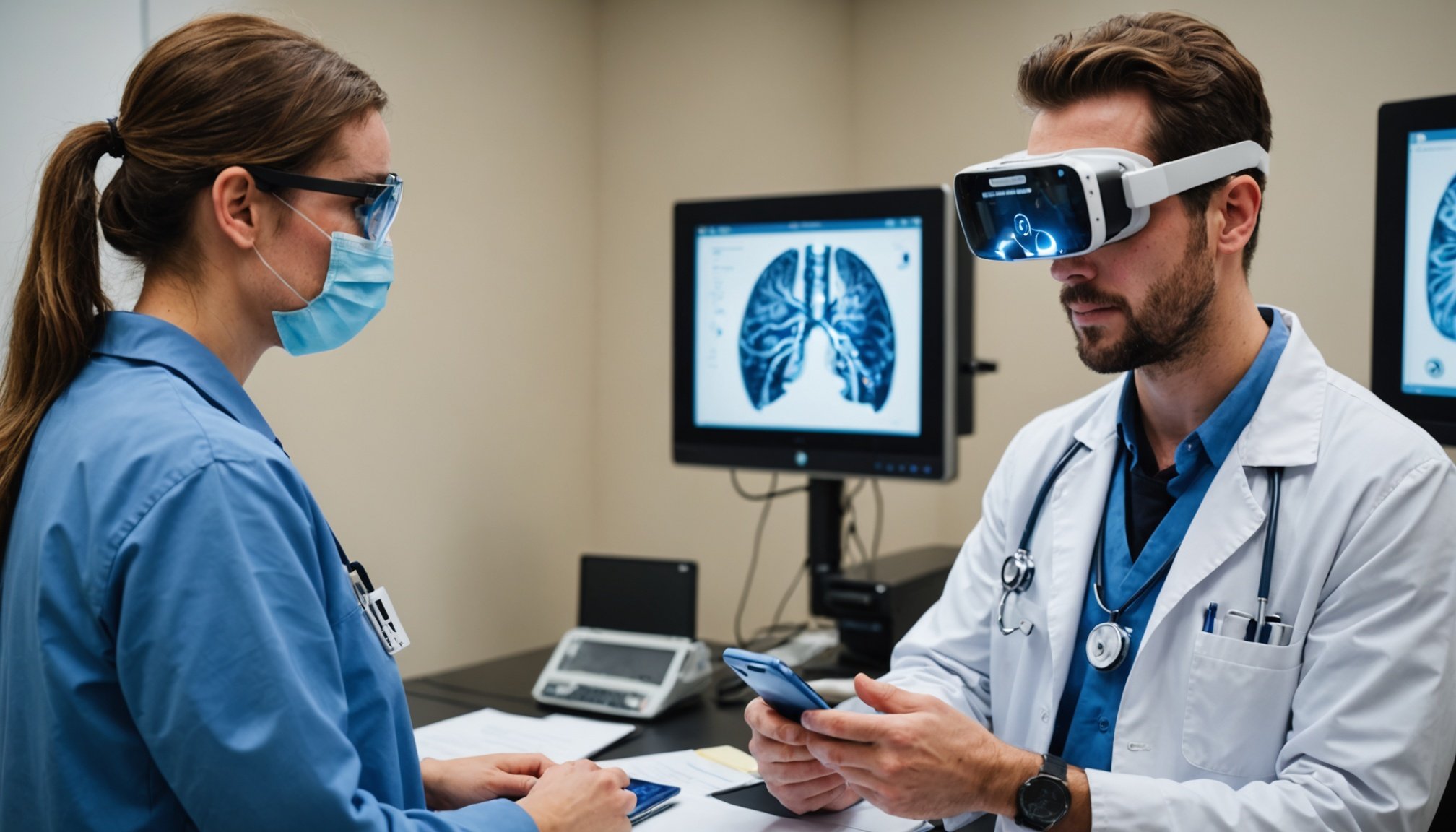Overview of Augmented Reality in Healthcare Training
Augmented Reality (AR) is revolutionising medical education by overlaying digital information onto the physical world, enhancing the training experience. Through sophisticated devices like smart glasses or mobile apps, AR blends real-world views with virtual elements, making complex concepts more tangible for learners.
The evolution of AR in medical education can be tracked back to the late 20th century, when it was initially experimented with for medical simulations. Back then, technological constraints limited its functionality. However, advancements in graphics and processing power have significantly expanded AR capabilities, leading to its widespread adoption across healthcare institutions.
Also read : Revolutionizing Aerospace Engineering: Leveraging AI to Enhance Predictive Maintenance for the Future
Today, AR is at the forefront of healthcare innovations, facilitating interactive learning environments and offering immersive experiences that were once unimaginable. Institutions are increasingly implementing AR, with current trends indicating a robust growth in its use for training medical professionals. A report by Healthcare Innovations suggests that adoption rates are doubling annually, signalling a shift towards more dynamic, tech-driven learning methods.
Additionally, the integration of AR in healthcare settings demonstrates the growing acceptance of technology-enhanced training. This shift is paving the way for more adaptable, comprehensive educational strategies, helping shape the future of medical training.
Have you seen this : Revolutionizing Online Verification: The Role of Blockchain Technology in Streamlining Digital Identity Authentication
Applications of Augmented Reality in Medical Education
The integration of AR Applications in Healthcare is transforming the educational landscape, particularly in medical training. It offers a wide range of interactive learning experiences, enhancing the understanding and application of complex concepts. One area where AR has made noteworthy contributions is in surgical simulations. By creating lifelike scenarios, it allows trainees to practice intricate procedures in a risk-free environment. This not only builds confidence but also fine-tunes their skills, ensuring better real-world performance.
Furthermore, AR is a powerful tool in anatomy visualization. Traditional methods often involve 2D diagrams, but AR provides immersive 3D experiences that are more intuitive for learners. By interacting directly with virtual models, students gain a comprehensive understanding of anatomical structures, fostering deeper learning.
In terms of patient interaction scenarios, AR enhances communication skills through simulated exchanges. Trainees can navigate various patient cases, learning to handle situations with empathy and precision. This form of training ensures that future healthcare professionals are not only skilled in technical aspects but also adept in patient interactions.
Overall, the medical training enhancements through AR create a dynamic and engaging learning environment, driving efficiency and effectiveness in healthcare education.
Case Studies Highlighting AR in Medical Training
Augmented Reality (AR) has been a cornerstone for evidence-based practices in medical education. Several case studies reveal how institutions leverage AR to enhance learning and improve healthcare outcomes. Take, for instance, the University of California, which implemented AR in its surgical residency programs. Trainees exposed to this technology experienced reduced error rates and improved procedural understanding. This demonstrates AR’s tangible impact on learner proficiency.
The Mayo Clinic offers another successful AR implementation example. By using AR applications tailored for anatomy classes, students gained a more profound grasp of complex structures. This immersive experience reported an increase in students’ retention rates and a more intuitive understanding of anatomical relationships. It exemplifies how AR tools can significantly shift traditional education methods towards more interactive learning processes.
Healthcare Innovations conducted a nationwide survey, gathering insights from educators and professionals regarding AR effectiveness. Results emphasize a strong correlation between AR integration and improved learning outcomes. Respondents praised AR’s capacity to simulate real-life scenarios, which better prepare students for clinical environments. Such evidence supports AR’s role in modernizing and optimizing medical training strategies.
These case studies underscore AR’s transformative potential in medical training, offering valuable practices for widespread adoption.
Benefits of Augmented Reality in Healthcare Training
The advantages of AR in healthcare training are profoundly altering how medical knowledge is acquired and applied. One of the most significant benefits is the improved retention and understanding of complex medical information. By allowing learners to interact with 3D models and simulations, AR bridges the gap between theoretical concepts and real-world application, leading to deeper comprehension and longer-lasting retention.
Another noteworthy benefit is the enhanced engagement and motivation among medical trainees. Interactive AR experiences make learning more dynamic, capturing students’ interest and encouraging them to explore intricate topics with enthusiasm. This engagement fosters an environment where curiosity and critical thinking can thrive, ultimately resulting in more capable and confident healthcare professionals.
Additionally, AR contributes to cost-effectiveness and resource optimization. Traditional training tools and materials can be expensive and difficult to access, but AR offers an accessible and scalable solution. By reducing the need for physical resources, institutions can allocate their budgets more efficiently, while still providing high-quality education.
This makes AR a practical choice for modernising medical training programs, ensuring they are both economical and innovative. As healthcare continues to evolve, AR’s advantages are poised to play a pivotal role in shaping the future of medical education.
Challenges and Limitations of AR in Medical Education
Augmented Reality (AR) in medical education faces a host of challenges and limitations, impacting its widespread adoption. First and foremost are the technological constraints associated with developing and maintaining high-quality AR tools. Precision in simulation is crucial for medical training, yet achieving it often requires advanced hardware and software, which are not always readily available. The complexity of creating realistic AR applications can pose significant hurdles for institutions aiming to integrate these technologies.
Moreover, resistance to change within educational frameworks presents another barrier. Many healthcare professionals and educators express skepticism about transitioning from traditional methods to AR-based learning. This resistance can stem from uncertainty about the effectiveness of AR or a lack of expertise in using such technology. Addressing these concerns demands comprehensive training and documentation to assist users in overcoming initial reluctance.
Financial implications also play a crucial role in the limited adoption of AR. The costs associated with acquiring and implementing AR infrastructure can be prohibitive for some institutions, particularly smaller ones. While AR does offer long-term cost benefits, the initial investment and ongoing maintenance costs need careful consideration. Balancing these financial aspects is essential for wider adoption and successful integration of AR in medical education.
Future Trends of Augmented Reality in Healthcare Training
The future of augmented reality (AR) in healthcare training is poised for exciting advancements, driven by ongoing technological innovations. Predictions for AR’s evolution focus on its potential to transform educational strategies within medical fields, offering more customised and effective learning environments.
One significant trend is the enhancement of interactive learning platforms. As AR technology continues to evolve, these platforms are expected to incorporate advanced features, such as real-time feedback and adaptive learning paths tailored to individual needs. This personalisation will address diverse learning curves, improving trainee outcomes.
Moreover, research and development efforts are pivotal for discovering new applications of AR in medical education. With a strong emphasis on interactive content, future AR systems could facilitate better engagement and understanding of complex medical scenarios. These advancements promise to redefine traditional education methods, providing immersive experiences that traditional teaching cannot replicate.
In addition, AR is anticipated to play a critical role in educational advancements, through fostering collaboration and knowledge sharing globally. By enabling virtual classrooms and cross-border partnerships, AR can bridge gaps in healthcare training access, reaching underserved regions.
Overall, the future of AR in healthcare is bound to revolutionise training methodologies, fostering wider implementation and acceptance within educational institutions.











